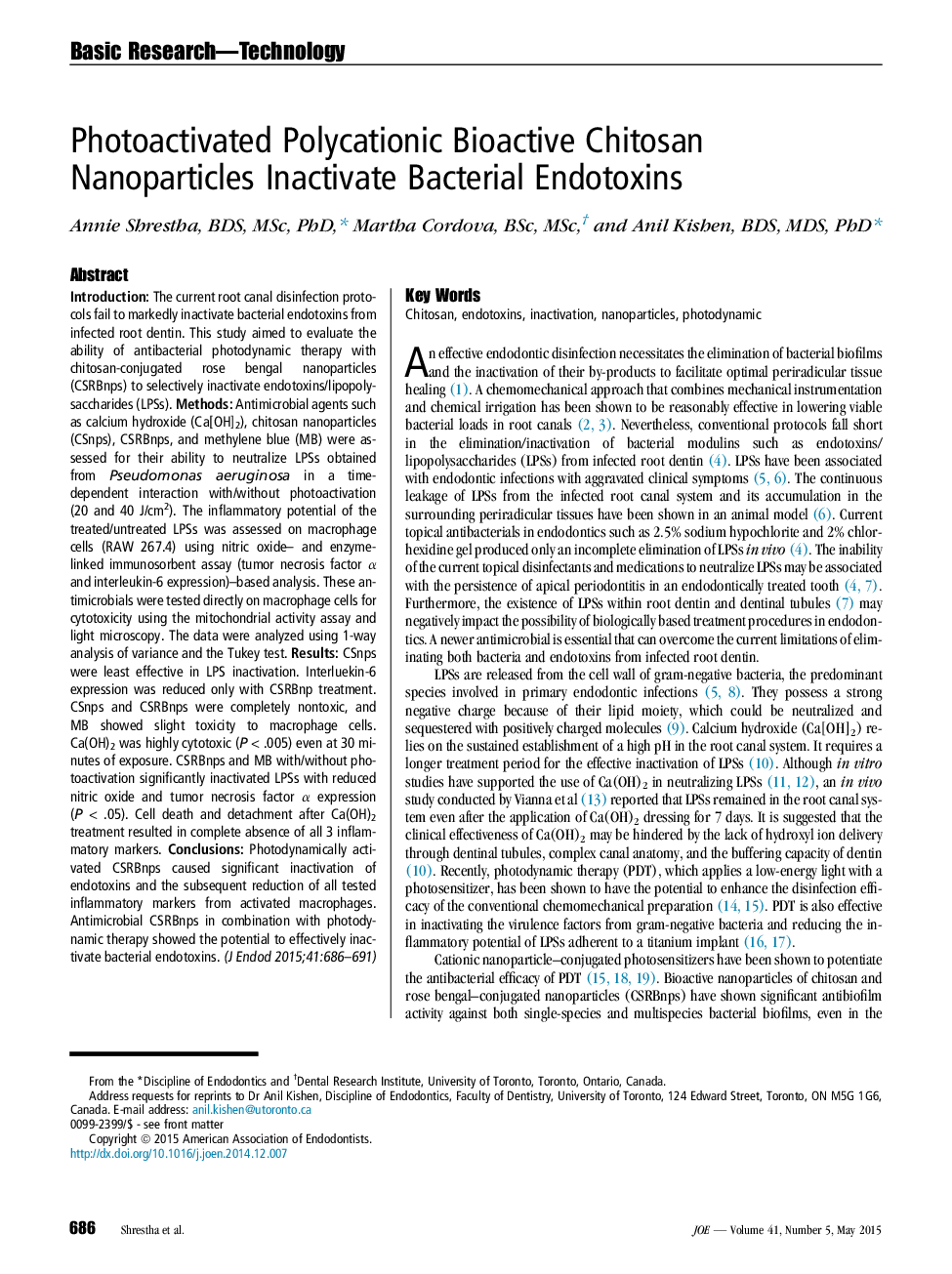| کد مقاله | کد نشریه | سال انتشار | مقاله انگلیسی | نسخه تمام متن |
|---|---|---|---|---|
| 3150292 | 1197507 | 2015 | 6 صفحه PDF | دانلود رایگان |

• This study evaluated the ability of antibacterial photodynamic therapy (PDT) with chitosan–conjugated rose bengal nanoparticles (CSRBnps) to selectively inactivate endotoxins/lipopolysaccharides (LPSs).
• Chitosan nanoparticles (CSnps) and CSRBnps were completely nontoxic, and methylene blue (MB) showed slight toxicity to macrophage cells. Calcium hydroxide was highly cytotoxic.
• CSRBnps and MB with/without photoactivation significantly inactivated LPSs with reduced inflammatory marker expression from activated macrophage cells. CSnps were least effective in LPS inactivation.
• The antimicrobial CSRBnps in combination with PDT showed the potential to effectively inactivate bacterial endotoxins without any direct cytotoxic effect on cells.
IntroductionThe current root canal disinfection protocols fail to markedly inactivate bacterial endotoxins from infected root dentin. This study aimed to evaluate the ability of antibacterial photodynamic therapy with chitosan-conjugated rose bengal nanoparticles (CSRBnps) to selectively inactivate endotoxins/lipopolysaccharides (LPSs).MethodsAntimicrobial agents such as calcium hydroxide (Ca[OH]2), chitosan nanoparticles (CSnps), CSRBnps, and methylene blue (MB) were assessed for their ability to neutralize LPSs obtained from Pseudomonas aeruginosa in a time-dependent interaction with/without photoactivation (20 and 40 J/cm2). The inflammatory potential of the treated/untreated LPSs was assessed on macrophage cells (RAW 267.4) using nitric oxide– and enzyme-linked immunosorbent assay (tumor necrosis factor α and interleukin-6 expression)–based analysis. These antimicrobials were tested directly on macrophage cells for cytotoxicity using the mitochondrial activity assay and light microscopy. The data were analyzed using 1-way analysis of variance and the Tukey test.ResultsCSnps were least effective in LPS inactivation. Interluekin-6 expression was reduced only with CSRBnp treatment. CSnps and CSRBnps were completely nontoxic, and MB showed slight toxicity to macrophage cells. Ca(OH)2 was highly cytotoxic (P < .005) even at 30 minutes of exposure. CSRBnps and MB with/without photoactivation significantly inactivated LPSs with reduced nitric oxide and tumor necrosis factor α expression (P < .05). Cell death and detachment after Ca(OH)2 treatment resulted in complete absence of all 3 inflammatory markers.ConclusionsPhotodynamically activated CSRBnps caused significant inactivation of endotoxins and the subsequent reduction of all tested inflammatory markers from activated macrophages. Antimicrobial CSRBnps in combination with photodynamic therapy showed the potential to effectively inactivate bacterial endotoxins.
Journal: Journal of Endodontics - Volume 41, Issue 5, May 2015, Pages 686–691